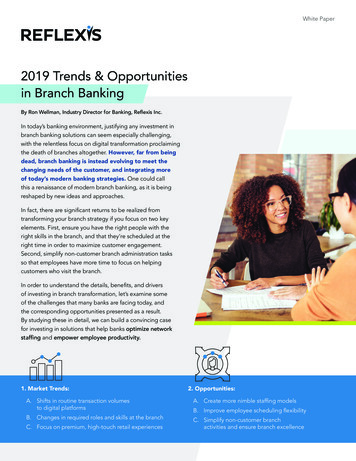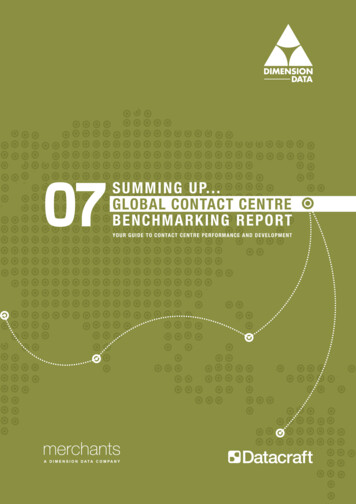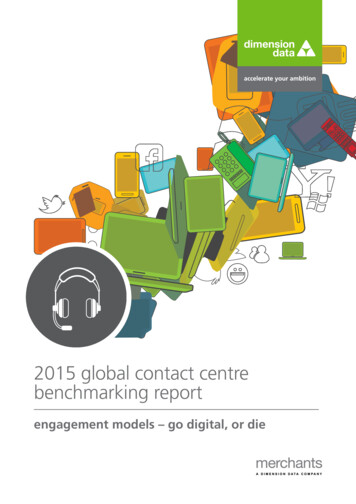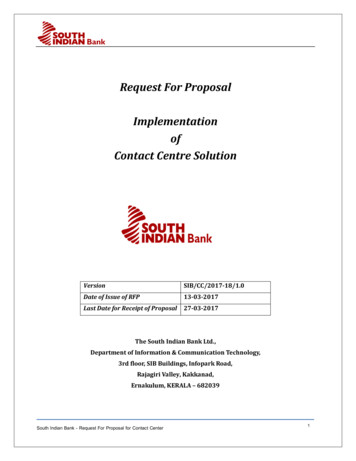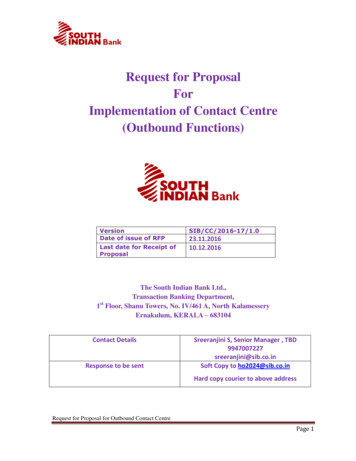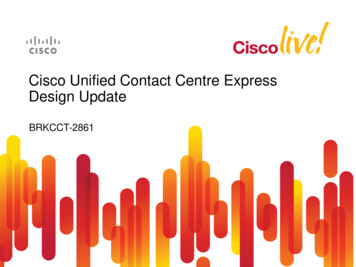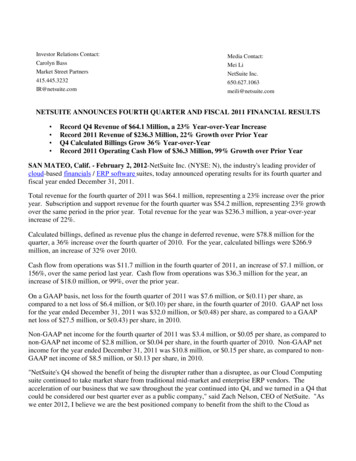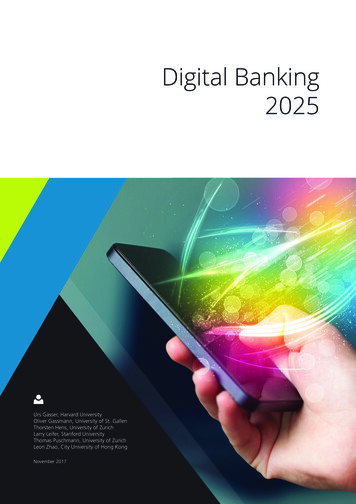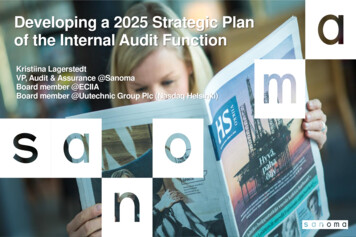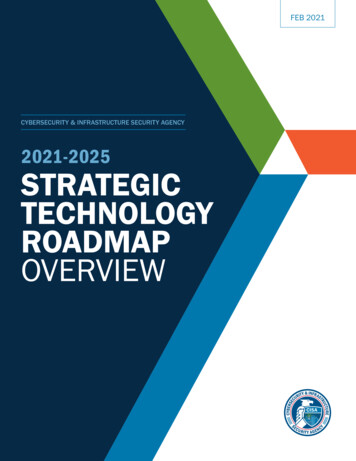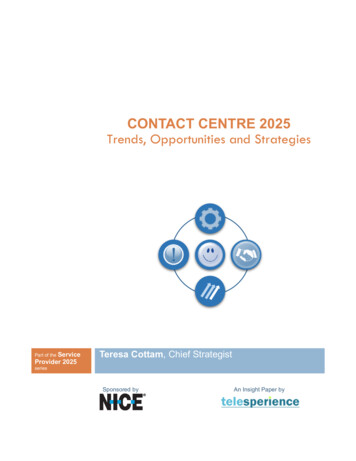
Transcription
CONTACT CENTRE 2025Trends, Opportunities and StrategiesServiceProvider 2025Part of theTeresa Cottam, Chief StrategistseriesSponsored byAn Insight Paper by
Contact centre 2025: Trends, Opportunities, StrategiesContentsIntroduction by Nice Systems . 3EXECUTIVE SUMMARY .4THE EVOLUTION OF CUSTOMER SERVICE.52.1 What this means for the contact centre . 8THE CONTACT CENTRE IS DEAD – LONG LIVE THEEXPERIENCE CENTRE! .93.1 What this means for the contact centre . 11THE SHIFT FROM COST CENTRE TO OPPORTUNITY CENTRE. 134.1 What this means for the contact centre . 15FROM SELF-SERVICE TO ‘SELFIE-SERVICE’ . 175.1 What this means for the contact centre . 20INTRODUCING MS BOND: THE SUPERAGENT OF THE FUTURE . 226.1 What this means for the contact centre . 25About this paper . 27About the author . 27Telesperience . 27About the sponsor . 27Page 2Telesperience 2016
Contact centre 2025: Trends, Opportunities, StrategiesIntroduction by Nice SystemsCustomer service organizations have always been in a continuous struggle to respond to the ever-changing landscapeof customer expectations. No other industry has had to adapt and evolve more quickly to the new era of theempowered consumer, the growing number of communication channels and the challenges of the new millennialemployee. And the contact center, with its special position, seated at the crossroads of customers, channel andemployees, has been leading the customer service evolution for decades.For over 30 years we, at NICE, have helped customer service organizations, and contact centers in particular, evolveby uncovering customer insight, predicting human intent and taking the right action to improve their business. We’vealways taken great pride in our unique perspective, at the forefront of supporting and enabling contact centers torespond to the complexities and challenges of creating perfect customer experiences.As we partner with organizations large and small to bring them world-class workforce optimization (WFO), analyticsand other advanced applications, we’ve done our part to help transform our industry from the call centers of the 80sand 90s to the modern contact center of today. We’ve seen our industry transition from voice to omni-channelRecording, from simple to multi-skilled workforce management and from random to interaction analytics-basedquality management. We’ve seen the introduction of performance management, desktop guidance & automation,voice of the customer, real-time authentication, customer journey analytics and many other additions to the range ofsolutions available to the contact centers of today.And while so many changes have come and gone over the years, one thing remains the same: Our thirst forunderstanding and uncovering the underlying cultural and technological trends shaping our industry, and our firmcommitment to continue to introduce visionary solutions that can help organizations leverage these trends to provideoutstanding customer service. We can’t wait to see how things will continue to evolve in the years to come. Welcometo the Contact Center in 2025.NICE, June 2016Telesperience 2016Page 3
Contact centre 2025: Trends, Opportunities, Strategies1.EXECUTIVE SUMMARYIn an increasingly complex, connected world the contact centre is set to become the interaction hub of the digitalenterprise – responsible for support, interaction, education and data gathering. But in its new role the contactcentre will have evolve to deal with more responsibilities and far more complex issues.While a wide range of technology - such as automation, analytics, workflow technology, bots, verification and soon - will be deployed to increase efficiency and enhance the experience, humans will still be required to deal withthe most complex and emotive issues. The range of skills required by human agents will also broaden and changeas they become problem solvers, co-creators of unique experiences, educators and brand-enhancingambassadors. At the same time, enterprises will have to deal with new demands from the next generation ofworkers who don’t want to work long shifts in centralised operations. In order to recruit and retain the best ofthese workers, enterprises will have to identify what these workers need from them in order to be seen as a goodemployer.Meanwhile, tomorrow’s customers will be creative, will communicate across an array of existing and newchannels but also in a new visual language. They will expect to co-create their experience via a continualinteraction with the enterprise and will want to take responsibility for many issues currently managed by thecontact centre to fulfil their desire for increased autonomy. The contact centre will support this by providinghints, tips, education and technical support.In addition, the contact centre will also become a powerful resource for finding out what customers think ofcompanies, and for capturing sentiments, feedback, needs and wants. As an invaluable source of data for boththe enterprise and its partners, it will evolve beyond omnichannel operation to become the centre of theconnected enterprise. And, as its mode of operation broadens and becomes more proactive, its success will haveto be measured by new metrics, reflecting its critical role in overall business performance.Moving call centre technologies to the Cloud will deliver far greater flexibility, but the enterprise will also need toconsider how it delivers service anywhere and at any time, as well as how it will utilise more distributed modelsof operation. Such models will require support from new infrastructure as well as a new recruiting approach.In the following sections we will consider how a number of key trends will shape customers’ expectations ofservice and the impact these will have on how companies deliver against these expectations. We will look at: How customer service is evolving (see Section 2 The Evolution of Customer Service)The evolution of the contact centre (see Section 3 ‘The Contact Centre is Dead – Long Live the Experience Hub)Business opportunities around support (see Section 4 ‘The Shift from Cost Centre to Opportunity Centre’)New customer requirements and behaviours, particularly the evolution of self-service (see Section 5 ‘FromSelf-Service to Selfie-Service’)What employees will need in order to perform their jobs more effectively and how companies can sourceand retain the right employees (see Section 6 ‘Introducing Ms Bond, the superagent of the Future’).In addition, we also provide a snap shot of how four key verticals – travel and hospitality, healthcare, financialservices and telecoms – will be affected by the changing requirements of customer service.Page 4Telesperience 2016
Contact centre 2025: Trends, Opportunities, Strategies2.THE EVOLUTION OF CUSTOMER SERVICEWithin the next few years, everything you know about customer service is going to be obsoleted by newtechnologies and channels. Or is it?Looking beyond the hype, the basics of customer service - the essential elements of what customers need andvalue, and their expectations based upon these fundamental needs - will remain remarkably persistent andconsistent. As shown in Figure 1, customers will still require you to be efficient, polite, know their name and takeresponsibility when things go wrong. These elements will continue to form the foundation of good customerservice, but the edifice of the service experience built upon these foundations will be far more idiosyncratic andmore dynamic. This will have profound impacts on how businesses manage the service experience in order tomeet evolving expectations from both customers and employees.Figure 1 The fundamentals and emerging expectations of customer serviceSource: Telesperience 2016By 2025, there will be a change in the notion of ‘customer’, resulting from the separation of the entity contactingthe contact centre for service and the customer themselves. For example, the rise of IoT will see smart objectsautomatically asking for support and help, with this support being provided by smart bots who will apply knownfixes, run diagnostics and search knowledge bases for answers or resolutions. Escalation to human technicianswill occur if the smart bot cannot resolve the issue. The human owner of the smart objects may be notified, ifappropriate, of any action taken, in the channel they have requested such notification to take place. Thus supportwill no longer be a human-to-human interaction, or even a human-to-bot interaction; it could involve no humans– other than reporting the resolution to a human owner.Telesperience 2016Page 5
Contact centre 2025: Trends, Opportunities, StrategiesThus there will be a distinction between the entity paying for the service and the entity receiving the service,which will also be apparent in the scenario where the ‘customer’ is a third-party company that has outsourcedservice provision and is paying the provider of service to support its customers.Vertical market differences will still persist in 2025 due to unique requirements (for example, as mandated byregulators or enshrined in law) and because they will concentrate on, and prioritise, different aspects of customerservice. However, in general customer expectations of service are set to rise across all verticals. By 2025,customers will have zero tolerance for sub-optimal service, as they will be even more informed about the realityof service, have far higher expectations, be empowered by social sharing, and be more willing and able to shiftsupplier. Perceptions of service performance will also commoditise far more rapidly with an innovation quicklymoving from exceeding expectations (delighting customers) to meeting expectations (satisfying customers) tobeing below expectations (creating dissatisfied customers).In the past, companies could claim exemptions from high levels of service based on the special conditions of thevertical they operate in, or because of lack of competition, arguing it was only necessary to perform at or abovethe norm for their industry. This customer service ‘get-out clause’ is already under pressure in 2016 and will beunstainable by 2025. This is because what customers perceive to be good service will increasingly becomevertical-agnostic and be driven by the highest performing companies in the most advanced verticals. The level ofservice these companies deliver will become ‘the new norm’ for all companies across all verticals. When acompany delivers enhanced service levels, customers will be alerted to what’s possible to provide and beginexpecting this level of service from other companies - irrespective of the vertical in which they operate.Moreover, the time it takes for service excellence to be heralded, championed, copied, expected, commoditisedand obsoleted will be far faster than in the past, due to the social, hyper-connected nature of the DigitalEconomy. Customers will share excellent examples of service with friends and strangers across a variety of media– alerting other customers to the very best and worst experiences and, in the process, informing other companiesof new developments in customer service and which ones resonate with customers.The Digital Economy will essentially provide a huge sandbox for ideation, experimentation and delivery of newservice paradigms. It will not only continually fuel expectations but also enable those companies who arelistening out for new ideas to source, copy, adapt and deliver them rapidly – speeding the innovation-tocommoditisation lifecycle.The increasingly vertical-agnostic nature of customer service was underlined by companies we spoke to as part ofthe research for this paper, who told us that they survey a range of vertical markets to see which ideas they couldadapt and build upon.Service innovation will therefore be like a pebble dropped into a pool, with excited ripples of social sharingwhich rapidly spread the idea, excite customers and then eventually fade – only for another idea to the bedropped in the service innovation pool (see Figure 2). This rapid widening of expectations will hold true bothacross verticals as well as in terms of geographical markets, as the internet platform continues to ‘flatten theworld’ and enable customers to experience service from a much more geographically-diverse range of companies.While cultural variation in terms of what is perceived as ‘good’ service will persist, this will gradually become lessdistinct and more homogeneous as customers sample service from more diverse locations, and businesses insearch of novel ideas shamelessly borrow new ones from wherever they
and other advanced applications, we’ve done our part to help transform our industry from the call centers of the 80s and 90s to the modern contact center of today. We’ve seen our industry transition from voice to omni-channel Recording, from simple to multi-skilled workforce management and from random to interaction analytics-based quality management. We’ve seen the introduction of .
